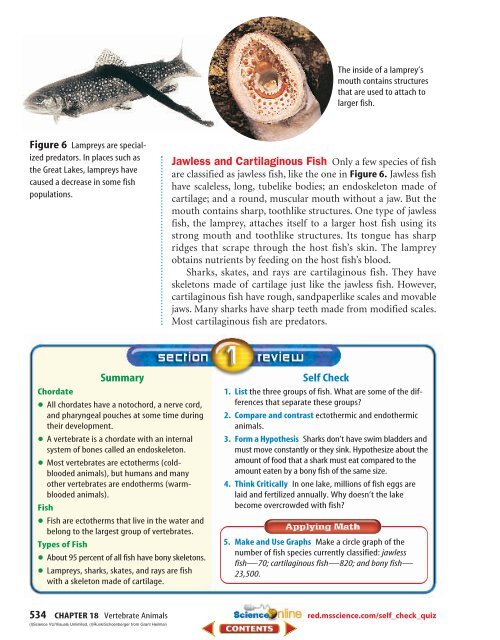Chapter 18: Vertebrate Animals
Chapter 18: Vertebrate Animals
Chapter 18: Vertebrate Animals
Create successful ePaper yourself
Turn your PDF publications into a flip-book with our unique Google optimized e-Paper software.
The inside of a lamprey’s<br />
mouth contains structures<br />
that are used to attach to<br />
larger fish.<br />
Figure 6 Lampreys are specialized<br />
predators. In places such as<br />
the Great Lakes, lampreys have<br />
caused a decrease in some fish<br />
populations.<br />
Jawless and Cartilaginous Fish Only a few species of fish<br />
are classified as jawless fish, like the one in Figure 6. Jawless fish<br />
have scaleless, long, tubelike bodies; an endoskeleton made of<br />
cartilage; and a round, muscular mouth without a jaw. But the<br />
mouth contains sharp, toothlike structures. One type of jawless<br />
fish, the lamprey, attaches itself to a larger host fish using its<br />
strong mouth and toothlike structures. Its tongue has sharp<br />
ridges that scrape through the host fish’s skin. The lamprey<br />
obtains nutrients by feeding on the host fish’s blood.<br />
Sharks, skates, and rays are cartilaginous fish. They have<br />
skeletons made of cartilage just like the jawless fish. However,<br />
cartilaginous fish have rough, sandpaperlike scales and movable<br />
jaws. Many sharks have sharp teeth made from modified scales.<br />
Most cartilaginous fish are predators.<br />
Summary<br />
Chordate<br />
•<br />
All chordates have a notochord, a nerve cord,<br />
and pharyngeal pouches at some time during<br />
•<br />
their development.<br />
A vertebrate is a chordate with an internal<br />
•<br />
system of bones called an endoskeleton.<br />
Most vertebrates are ectotherms (coldblooded<br />
animals), but humans and many<br />
other vertebrates are endotherms (warmblooded<br />
animals).<br />
•<br />
Fish<br />
Fish are ectotherms that live in the water and<br />
belong to the largest group of vertebrates.<br />
Types of Fish<br />
•<br />
About 95 percent of all fish have bony skeletons.<br />
Lampreys, sharks, skates, and rays are fish<br />
with a skeleton made of cartilage.<br />
Self Check<br />
1. List the three groups of fish. What are some of the differences<br />
that separate these groups<br />
2. Compare and contrast ectothermic and endothermic<br />
animals.<br />
3. Form a Hypothesis Sharks don’t have swim bladders and<br />
must move constantly or they sink. Hypothesize about the<br />
amount of food that a shark must eat compared to the<br />
amount eaten by a bony fish of the same size.<br />
4. Think Critically In one lake, millions of fish eggs are<br />
laid and fertilized annually. Why doesn’t the lake<br />
become overcrowded with fish<br />
5. Make and Use Graphs Make a circle graph of the<br />
number of fish species currently classified: jawless<br />
fish—70; cartilaginous fish—820; and bony fish—<br />
23,500.<br />
534 CHAPTER <strong>18</strong> <strong>Vertebrate</strong> <strong>Animals</strong><br />
(l)Science VU/Visuals Unlimited, (r)Runk/Schoenberger from Grant Heilman<br />
red.msscience.com/self_check_quiz

















